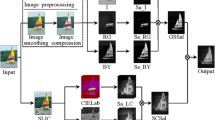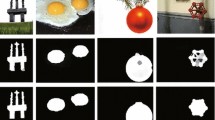Abstract
Detection of visual saliency is an important issue in many computer vision tasks. In this paper, we propose a novel regional contrast based saliency detection method, generating a saliency map that enables high contrast between the foreground salient object and background. Our method mainly integrates four principles, which are based on psychological evidences, visual research and general observation. In order to suppress the homogeneous regions, and let the novel regions stand out, our method computes a region’s saliency value based on the region’s N closest regions defined in the CIE L*a*b color space. We compared our method with the state-of-the-art saliency detection methods using a standard publicly available database. Experimental results show that our method has better performance on yielding higher precision and recall rates. In the application of image editing, we demonstrate that using our saliency map as energy map can achieve more appealing retargeting results with less distortions in the important regions.
Access this chapter
Tax calculation will be finalised at checkout
Purchases are for personal use only
Preview
Unable to display preview. Download preview PDF.
Similar content being viewed by others
References
Avidan, S., Shamir, A.: Seam carving for content-aware image resizing. ACM Transactions on Graphics 26(3), 2462–2470 (2007)
Han, J., Ngan, K.N., Li, M.J., Zhang, H.J.: Unsupervised extraction of visual attention objects in color images. IEEE Transactions on Circuits and Systems for Video Technology 16, 141–145 (2006)
Rutishauser, U., Walther, D., Koch, C., Perona, P.: Is bottom-up attention useful for object recognition? In: IEEE CVPR, pp. 37–44 (2004)
Itti, L., Koch, C., Niebur, E.: A model of saliency-based visual attention for rapid scene analysis. IEEE TPAMI 20(11), 1254–1259 (1998)
Koch, C., Poggio, T.: Predicting the visual world: silence is golden. Nature Neuroscience 2(1), 9–10 (1999)
Treisman, A., Gelade, G.: Predicting the visual world: silence is golden. Cognitive Psychology 12(1), 97–136 (1980)
Wolfe, J.M.: A revised model of visual search. Psychonomic Bulletin & Review 1(2), 202–238 (1994)
Judd, T., Ehinger, K., Durand, F., Torralba, A.: Learning to predict where humans look. In: ICCV, pp. 2106–2113 (2009)
Rother, Felzenszwalb, P.F., Huttenlocher, D.P.: Efficient Graph-Based Image Segmentation. IJCV 59(2), 167–181 (2004)
Cheng, M.M., Zhang, G.X., Mitra, N.J., Huang, X.L., Hu, S.M.: Global contrast based salient region detection. In: CVPR, pp. 409–416 (2011)
Gorisse, D., Cord, M., Precioso, F.: Locality-Sensitive Hashing for Chi2 Distance. IEEE TPAMI 34(2), 402–409 (2012)
Rubner, Y., Tomasi, C., Guibas, L.J.: The Earth Mover’s Distance as a Metric for Image Retrieval. IJCV 40(2), 99–121 (2000)
Achanta, R., Hemami, S., Estrada, F., Susstrunk, S.: Frequency-tuned salient region detection. In: CVPR, pp. 1597–1604 (2009)
Hou, X.D., Zhang, L.Q.: Saliency Detection: A Spectral Residual Approach. In: CVPR, pp. 1–8 (2007)
Harel, J., Koch, C., Perona, P.: Graph-based visual saliency. In: NIPS, pp. 545–552 (2006)
Achanta, R., Estrasda, F., Wils, P., Susstrunk, S.: Salient Region Detection and Segmentation. In: Gasteratos, A., Vincze, M., Tsotsos, J.K. (eds.) ICVS 2008. LNCS, vol. 5008, pp. 66–75. Springer, Heidelberg (2008)
Goferman, S., Zelnik-Manor, L., Tal, A.: Context-aware saliency detection. In: CVPR, pp. 2376–2383 (2010)
Ma, Y.F., Zhang, H.J.: Contrast-based image attention analysis by using fuzzy growing. In: ACM MM, pp. 374–381 (2003)
Author information
Authors and Affiliations
Editor information
Editors and Affiliations
Rights and permissions
Copyright information
© 2012 Springer-Verlag Berlin Heidelberg
About this paper
Cite this paper
Fan, Q., Qi, C. (2012). Similar Region Contrast Based Salient Object Detection. In: Hu, SM., Martin, R.R. (eds) Computational Visual Media. CVM 2012. Lecture Notes in Computer Science, vol 7633. Springer, Berlin, Heidelberg. https://doi.org/10.1007/978-3-642-34263-9_14
Download citation
DOI: https://doi.org/10.1007/978-3-642-34263-9_14
Publisher Name: Springer, Berlin, Heidelberg
Print ISBN: 978-3-642-34262-2
Online ISBN: 978-3-642-34263-9
eBook Packages: Computer ScienceComputer Science (R0)




